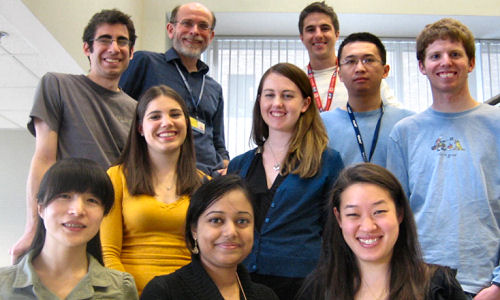Johns Hopkins biochemists have figured out what is needed to activate and sustain the virus-fighting activity of an enzyme found in CD4+ T cells, the human immune cells infected by HIV. The discovery could launch a more effective strategy for preventing the spread of HIV in the body with drugs targeting this enzyme, they say. A summary of their work was published online on April 21 in the journal Proceedings of the National Academy of Sciences.
Stivers Lab, johns hopkins university school of medicine.
“Current antiretroviral drugs target HIV’s proteins,” says James Stivers, Ph.D., a professor of pharmacology and molecular sciences at the Johns Hopkins University School of Medicine, “but those proteins are moving targets because they are often altered by mutations. SAMHD1, a human protein, plays a major role in HIV’s devastation of the immune system and is rarely mutated, so we are hopeful that it will be a better target for therapies.”
The studies were inspired, Stivers says, by the fact that when an HIV virus infects a new CD4+ T cell, it injects its genetic information into the cell as two strands of RNA, the molecular cousin of DNA. To highjack the cell, the viral RNA must be converted into a strand of DNA, which can then insert itself into the host cell’s genome. There, the viral genes will be turned on and the cell will unwittingly begin making viral proteins.
None of that can happen, however, if the nucleotide building blocks of DNA have been depleted from the cell. (Nucleotides come in four varieties: the A’s, T’s, C’s and G’s of the genetic code.) Stivers knew that depleting nucleotides by breaking them down into pieces that quickly leave the cell is precisely the job of SAMHD1, a protein recently discovered in humans but thought to have first evolved in bacteria as a defense against viruses. Since nucleotides are needed to build duplicate copies of a cell’s DNA before it can divide, SAMHD1’s activity is carefully regulated so that it is active only when the cell is at rest and not dividing.
More recently, scientists have realized that SAMHD1’s activity is a double-edged sword. Its depletion of nucleotides leaves HIV capable of making just a few incomplete pieces of DNA that cause great harm to their host by stimulating an inflammatory response, causing nearby CD4+ T cells to commit suicide. As a mainstay of the immune system, plummeting CD4+ T cell numbers leave HIV-positive individuals nearly defenseless against any viruses and bacteria that try to invade, leading researchers to believe that patients might be better off without SAMHD1. This belief is bolstered by the fact that a certain version of HIV brings its own SAMHD1 inhibitor into the cell, and patients infected with this version fare much better.
In a bid to understand SAMHD1 better and perhaps learn to block it, Stivers’ team used biochemical tests to learn what is needed to turn it on and keep it functioning. It was already known that active SAMHD1 consists of four identical units that work together as a whole. Each unit contributes three binding pockets: one for the A, T, C or G nucleotide that gets broken down and two for activator molecules, another A, T, C or G nucleotide and a molecule of guanine triphosphate (GTP).
The team found that binding of GTP to individual units promotes their coming together in pairs. When two nucleotides bind to a pair of units, the pair is then able to connect with another pair to form the four-part active enzyme. That means, Stivers says, that the nucleotides are not only acted upon by the enzyme, but are also necessary for it to come together.
Further tests revealed that this dual role allows nucleotides to fine-tune SAMHD1’s activity. While most enzymes remain active only as long as their activators are bound, Stivers’ group found that SAMHD1 remains active for about half a day after its activators have fallen off, enabling the enzyme to get cellular nucleotides to really low levels that make it almost impossible for HIV to infect cells.
“The persistence of activated SAMHD1 long after essential activators have fallen off allows it to continue to break down nucleotides, even after their levels are too low to activate the enzyme,” says Stivers. “That’s how SAMHD1 can get the nucleotide levels so low that viruses are thwarted.”
The researchers say that while inhibiting SAMHD1 would leave patients without a tool for fighting viruses, it may prevent the killing of the immune cells required to combat HIV. “Now that we understand how activation of SAMHD1 works, we have developed a small molecule that inhibits its subunit assembly. This is a nice starting place for further inhibitor design,” says Stivers.
Story Source:
The above story is based on materials provided by The Johns Hopkins University, Catherine Kolf.





